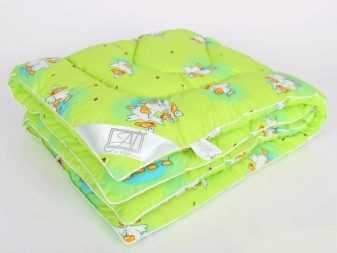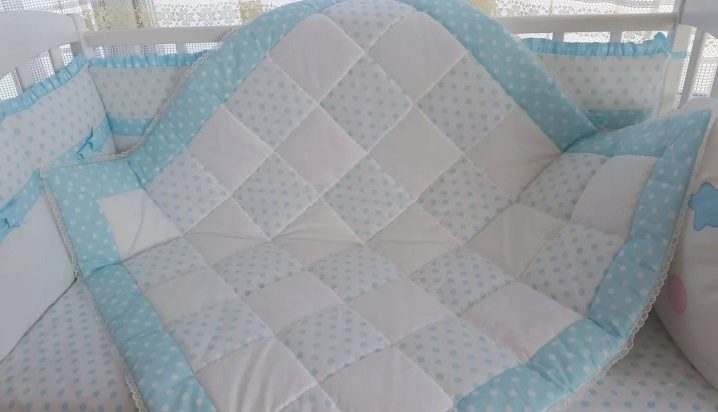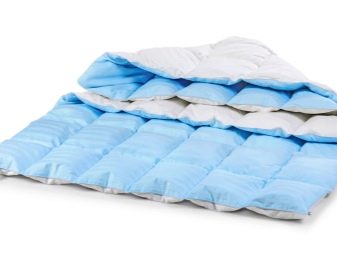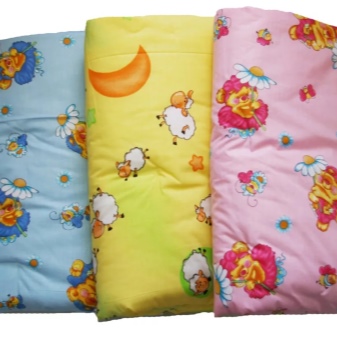Blankets for newborns

With the birth of a baby, it is important to take care of buying a blanket that will always maintain a cozy atmosphere for the newborn. In his choice, it is important to take into account a number of nuances: having been born, the baby needs warmth, a kind of cocoon that will be associated with his mother, and therefore peace. Newborn blankets are the very first blankets for babies. They have their own characteristics and are subject to certain requirements.

Blanket requirements
A baby blanket is a special topic. In infancy, the bones of the baby are still soft and susceptible to any impact. Any product that comes into contact with the child's body must be made in accordance with certain requirements so as not to harm him.

In no case should you cover your baby with your blanket: due to its heavy weight, it can cause breathing difficulties and cause general discomfort.

To eliminate health risks and ensure maximum benefits, special requirements for baby blankets have been developed.
Such products should:
- obey seasonality (to be warm regardless of the season, taking into account the specific season and temperature in the room);
- be of optimal size (a small product is not able to provide warming of the whole body, a large version prevents any movement of the baby);
- have air exchange (the ability to warm the body, while allowing the skin to "breathe" and excluding the formation of prickly heat);

- be lightweight (a heavy blanket can disrupt the baby's natural breathing, which will deprive sleep of comfort and relaxation);
- have good hygroscopicity (the ability to absorb moisture and release it into the air);
- warm the body in the right amount (when cooling, the child constantly wakes up, therefore, one cannot do without an optimal constant temperature inside to ensure a full and long sleep);
- be hypoallergenic (made from quality raw materials that do not irritate the delicate and sensitive skin of the baby);
- performed without excessive decorthat can entangle the arms or legs of the newborn;
- be safe (excluded long pile, low-quality fiber, which is easily pulled out by mechanical stress).
In addition, the dye is important: toxins and dangerous paint impurities are unacceptable, even if in order to ensure the softness and beautiful appearance of the product.

Functions
Blankets for babies are miniatures for adults, however, their warmth should be delicate. They are a kind of protection for the baby from external factors, and although such products cannot be compared with mother's warmth, they are able to perform several tasks.
Blankets for newborns:
- are the first classic baby blanket used in the usual way;
- are relevant when you are discharged from the hospital;
- depending on the type of filler, they can become a mattress topper, varying the degree of hardness of the mattress, giving the sleeping place coziness and convenience;
- do an excellent job with the function of the diaper insulation, covering the baby from all sides;
- based on the model, it can be a blanket that covers the sleeping place and gives it tidiness;
- if necessary, replace the envelope, reliably "packing" the newborn at any time of the year: save from the cold and wind (important when walking in the fresh air);
- depending on the density and type of filler, they can become the first rug, located on the surface of the mattress or on the floor (after two to three months, when the baby begins to crawl and explore the world around him).
In most cases, baby blankets are packed in a textile duvet cover made of natural fabric: this way the warming properties are better expressed, and, in addition, it is hygienic and does not allow the padding to enter the baby's respiratory tract.


Views
Blankets for newborns are produced in two types: open and closed. Varieties differ in weight, filler layer and composition. Some models are intended for the cold season (warm winter), others are relevant for the off-season and summer.
According to the method of making blankets, there are:
- woven - made of intertwined threads;
- non-woven - with a bulky fibrous base.
The first models look thinner, mostly summer bedspreads (dense textile fabrics). The latter can be of a fur plan (plaid, transformer, cocoon blanket, Velcro model) or quilted.

Fur options are divided into one-sided (with a jacquard cotton base) and two-sided (with dressing of two sides of the blanket). Products in this line are finished with wide knitted piping. They warm well, but due to the nap they need a cotton duvet cover.


The main line of products for newborns is made up of quilts. In them, the padding layer is closed on both sides with a textile cover made of cotton fabric. Depending on the model, the design of the blanket may be different:
- textiles are quilted in the form of a simple pattern;
- the cover is made by hand from separate fragments with subsequent stitching (patchwork technique).


Baby blankets for babies are divided into lightweight, cassette and demi-season. In lightweight products, the amount of material used is less, therefore such products heat less.

Standard options include more raw materials and therefore have better thermal performance. The warmest are those in which natural filler is used in greater quantities.

Knits are not toddler's first blankets. These are decorative blankets that do not have the desired warming effect and the required degree of softness.

Which one is better to choose?
When choosing a winter warm or light summer blanket for a crib (for a walk), one should proceed from a number of factors:
- compliance with the stated requirements;
- medical indications (relevant for allergy sufferers);
- availability of a certificate of quality and compliance with hygiene standards;
- suitable size and thickness;
- acceptable cost;
- heat level;
- ease of care.

If you choose between a down and a woolen product, you should give preference to the second options.
The benefits of such blankets are confirmed by doctors, because the models are made of wool:
- strengthen the baby's immunity, maintaining his health and resistance to colds;
- have a relaxing and light massage effect, relieving muscle tension and calming the nervous system;
- have low thermal conductivity, not allowing body heat to penetrate outside, maintain the most comfortable conditions for sleeping, prevent freezing;
- improve metabolic processes, blood flow;
- having a natural antiseptic lanolin in its composition, soothe the skin;
- have an antibacterial effect.
If there is a risk of allergies, it is best to purchase a cotton or synthetic blanket.


How to determine the degree of heat?
To know the degree of heat, you can take note of the information indicated on the product packaging, indicated by dots:
- one dot indicates that the blanket is only suitable for summer;
- two dots indicate that the product is included in the group of standard lightweight blankets;
- three points - this is already a model for the autumn-spring period;
- four dots emphasize that the selected option is warm enough;
- five points - the warmest blanket with the maximum comfort.

Subtleties of color (open models)
Oddly enough, the color of the blanket is of great importance: bright and aggressive colors can scare a baby, while gentle shades of the pastel group create a welcoming atmosphere.
In addition, it is important to take into account the "warmth" of the shade: an incorrectly selected tone (especially cold) can affect the mood, causing crying or whims. Sunny, cheerful drawings develop a positive attitude towards everything that surrounds.

Dimensions (edit)
The size of the blanket should not be too small, because in a month the baby will noticeably grow up. It will be visible to the naked eye every month.
To make it easier to understand which size to choose, it is worth starting from the size of the crib, choosing a blanket for its dimensions. The smallest permissible option is 60x120 cm.However, it cannot be called convenient: it will not be possible to wrap a baby in it for a walk. At best, such a blanket will later become a small rug.

It is important to choose the larger version that will last longer. The average sizes of blankets for babies are 100x80, 90x120, 105x115, 135x100 cm. You can purchase a spacious 140x110 cm model, which will last for a couple of years.

If you plan to sometimes use the blanket as a mattress cover, you should measure the mattress and add small allowances (to wrap the blanket under the mat).


Materials (edit)
Depending on the type of filler, raw materials can be of natural or artificial origin. It is conventionally divided into summer and winter types.
The winter line of high-quality fillers for the first blankets of babies includes:
- natural sheep, camel and llama, alpaca wool - natural material with "dry" heat, which has not only warming, but also useful properties, however, not suitable for allergy sufferers;
- down (goose, swan) - a filler that combines lightness and thermal characteristics, capable of maintaining the desired level of heat without overheating (good, but not practical to care for, requiring regular drying and problematic material in washing, which feather mites love);
- bamboo - eco-friendly antibacterial fiber with UV protection, heat-insulating and hygroscopic properties, resistant to multiple washings (excellent silky padding, however, very expensive);

- cotton (wadding) - a running natural filler with a good volume and high thermal characteristics (unfortunately, it is heavy for a baby, during operation it changes the density of the structure, due to which it gets bunched up);
- silk - natural fiber with excellent wear resistance, does not create a greenhouse effect (high-quality and expensive padding);
- fur - a special dressing of natural or synthetic fibers, which has an elastic base, which ensures a strong attachment of the fibers themselves (an excellent option is a blanket, a transforming blanket for walking);
- holofiber and hollophane - lightweight synthetic materials on a non-woven basis made of polyester fibers (100% polyester) with a hollow structure of fiber-springs (high-quality stuffing, but with a slight greenhouse effect);
- sintepon - a cheap analogue of holofiber, which is not restored after washing, almost always loses its properties (cakes, gets lost in separate heaps).
The disadvantage of synthetic blankets is poor air permeability, so the purchase of such products for newborns is undesirable.

Summer blankets include the following models:
- flannel and flannel - hypoallergenic natural cotton products with a soft texture, heat retention and good ventilation, excluding the appearance of diaper rash and prickly heat (traditional options for summer, which calmly tolerate washing with soap or ordinary washing powder);
- linen - lightweight, hygroscopic products, relevant for hot summer days, saving the skin from the sun;
- fleece - soft and pleasant to the body models, characterized by low weight and thickness (synthetic knitted fabrics that do not require special care, however, subject to dust accumulation).
If we compare the indicators of softness, the softest and most pleasant to the baby's body are woolen, fleece, bamboo, down and wadded blankets. Baikovye, jacquard, cotton products with a mesh are denser, and therefore do not envelop the baby, like voluminous counterparts.

Accessories
Accessories for blankets for newborns include wide ribbons, round bows or their mix (belt-bow). Such additions add elegance to the blanket, they are especially in demand when leaving the hospital, going for a walk.

In addition to the decoration, the blankets are complemented by a functional and practical accessory - a duvet cover. It gives any product a neat look, protects it from natural dirt and thereby extends its service life. In addition to functionality, the duvet cover makes the duvet warmer and the interior atmosphere cozy and inviting to sleep.

Depending on the gender of the child, the color of the accessories can be blue (for a boy) or pink (for a girl). Although manufacturers often offer universal options made in white, yellow, green and other pastel colors.

How to care?
A blanket for newborns loves delicate care. If the product is not properly maintained, it will lose its softness and may become rough to the touch.
To extend the operational properties of the product, it is worth taking note of a number of nuances:
- one blanket is not enough (while one is drying after washing, the child needs to be covered with something);
- drying and airing are mandatory (this excludes caking of the material and the appearance of an environment for the formation of linen mites and dust);
- a spare woolen blanket should be stored exclusively in a breathable cover with free air access (polyethylene is excluded - with such storage, the moth will not keep itself waiting long);
- if time permits, it is better to wash the blankets by hand (there is less deformation of the fibers and a violation of the softness of their structure);
- machine washing is allowed only in woven models of cotton, linen, fleece (gentle mode at 30 - 40 degrees and use of baby soap);


- wool blankets made of sheep, camel wool and cashmere are not machine washable (the structure of the fibers changes, reducing the distance between them);
- it is preferable to wash bulky synthetic products by hand;
- the bamboo blanket is vacuumed and ventilated;
- the duvet requires dry cleaning, but is not machine washed;
- it is not recommended to twist the blankets (you need to let the water drain, then gently squeeze out the remaining water);
- drying is carried out in a natural way (no ironing or drying on a heater, there can be no battery: this damages the structure of the fibers).


You will learn more about a blanket made of sheep fur for newborn babies in the following video.













The comment was sent successfully.